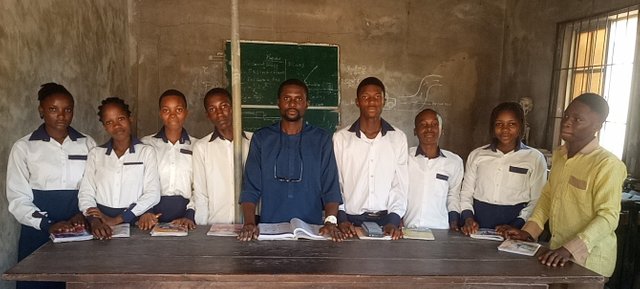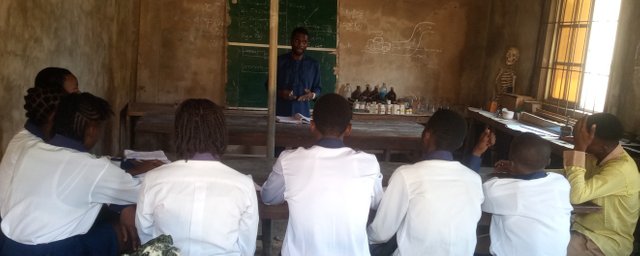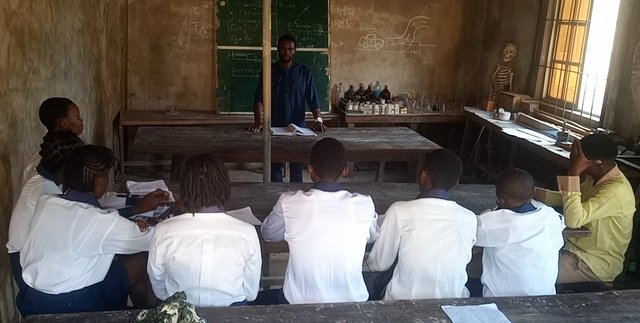SLC | S21W2: Effective Classroom Management
Hello everyone, I am glad to be part of this community and participate in week 2 of the season 21 steemit learning contest. This is my first publication here and I look forward to making it worthwhile.
 Me & My GOMA Students Me & My GOMA Students |
|---|
1. To The Best Of Your Knowledge, What Is Effective Classroom Management, And What Does It Have To Do With Planning, Implementing, Evaluating Learning, And Utilizing Resources Optimally? Explain The Relationship Of Each Of These Points Using Your Language. |
|---|
Effective classroom management is a very important facet of teaching that embraces different strategies, techniques, as well as practices to generate a productive, respectful, and inclusive learning environment. It includes planning, implementing, evaluating learning, and optimal utilization of resources to ensure teachers achieve their specific objectives and students achieve academic success.
Planning, implementing, evaluating learning, and utilizing resources optimally are key components of effective classroom management.
Planning:
This setting explicit learning goals and outcomes, formulating engaging lesson plans, instituting classroom routines and procedures, and creating a positive classroom culture.
Implementing:
Implementing involves effective instruction delivery, managing student behavior, and reducing disruptions. Encouraging active participation and engagement and making feedback and support attainable.
Evaluating Learning:
Evaluating learning has to do with the assessment of students' understanding and progress, instruction adjustments to meet various needs, utilizing data-driven strategies to effect teaching, and celebrating students' achievements.
Utilizing Resources Optimally:
Utilizing resources optimally is all about leveraging technology to improve learning, efficient allocation of time and materials, collaborating with associates and support staff, and fostering community involvement.
By implementing thorough classroom management strategies, teachers can give rise to a supportive, inclusive, and productive learning environment that nurses academic success and social growth.
2. How Do You Go About Creating A Classroom Atmosphere That Supports The Learning Process?, The Explanation You Give Is Based On Personal Experience That Did. |
|---|
Creating a supportive classroom atmosphere is consequential for effective learning. It goes beyond the physical environment, as it also involves the emotional, social, and intellectual environment, strategies to support Learning, teacher behaviors, student-centered practices, classroom routines, and Procedures, as well as continuous improvement
I will be explaining each of the above stated based on my personal experiences and practices.
Physical Environment:
This involves a sitting arrangement tailored towards promoting interaction and collaboration, guaranteeing proper ventilation, good lighting, and temperature. Reducing distractions such as noise and visual clusters, displaying applicable educational materials and inspirational quotes. In most cases and places, include plants or calming colors.
Emotional Environment:
Emotion cannot be separated from teaching; hence, concerning the emotional environment, we establish a positive and inclusive classroom culture, nurse empathy, respect, and communication. Furthermore, active listening and constructive feedback are encouraged, prompt and fair address of conflicts, celebration of diversity, and promotion of cultural awareness.
Social Environment:
The social environment involves building derf relationships with students, encouraging teamwork, peer support and collaboration. Developing a sense of community via class activities, fostering leadership and responsibility as well as creating opportunities for socialization.
Intellectual Environment:
Building an intellectual environment involves encouraging curiosity, critical thinking, and inquiry, providing engaging and challenging learning experiences. Also, it has to do with incorporating real-world applications and relevance, fostering innovation and creativity, as well as emphasizing analytical skills and problem-solving.
Strategies to Support Learning:
This is all about formulating strategies that support learning, which may include integration of technology, differentiated instruction, flexible grouping (small groups, individual, whole-class), formative assessments, and feedback.
Teacher Behaviors:
This is another very crucial facet, it is all the characteristics and personality of the teacher. To create a classroom atmosphere that supports the learning process, a teacher should be approachable, passionate, and enthusiastic, demonstrate confidence and expertise, and utilize positive body language as well as nonverbal cues. The teacher should equally practice active listening and empathy and show interest in students' lives and interests.
Student-Centered Practices:
This is another area of interest in creating a classroom atmosphere that supports the learning process. It involves carrying out student-led conversations or debates and presentations, fostering choice-based learning activities, self-assessment, and reflection. It also has to do with peer review and feedback as well as learning portfolios and journals.
Classroom Routines and Procedures:
Formulating and maintaining classroom routines and procedures are essential for creating a classroom atmosphere that supports learning. It establishes explicit expectations and rules, develops effective time management and transition, and affects classroom management strategies. Utilizes visual reminders and organizational tools and encourages students' responsibility and accountability.
Continuous Improvement:
Continuous improvement should be seen in the teacher as it incites the students. Therefore, continuous improvement reflects on teaching practices, looks for student feedback, and helps the teacher collaborate with colleagues. It also helps the teacher stay updated on optimum teaching practices and adjust instructions to meet evolving needs.
Implementation of these strategies creates a supportive classroom atmosphere that nurses academic success, social growth, as well as emotional well-being.
 In A Physics Class In A Physics Class |
|---|
3. According To Your Experience And Observations, What Factors Can Hinder Effective Classroom Management? Explain Why These Things Are A Hindrance. |
|---|
The following are some factors that can hinder effective classroom management, along with explanations of why they are hindrances:
Teacher-Related Factors
- Poor time management: Disorganization can lead to wasted class time and mitigated learning opportunities.
- Lack of training or experience: Insufficient preparation can result in inconsistent discipline as well as poor lesson planning.
- Inconsistent discipline: Unequal treatment can nurse indignation and disrupt the learning environment.
- Ineffective communication skills: Inexplicit expectations and poor communication can befuddle students and result in behavioral issues.
- Burnout or stress: Teacher emotional depletion can negatively impact student relationships as well as instructional quality.
Student-Related Factors
- Socioeconomic disparities: Unmet basic needs can impinge student focus and motivation.
- Emotional challenges (e.g., anxiety, trauma): Unsupportive environments can frustrate student struggles.
- Diverse learning styles and abilities: Disregarding individual needs can result in behavioral issues and disengagement.
- Language barriers or cultural differences: Unaddressed linguistic or cultural space can hinder comprehension and engagement.
- Behavioral issues (e.g., impulsivity): Undiscussed challenges can interrupt or impede the learning environment.
Environmental Factors
- Noise or distractions: Environmental disruptions can mitigate focus and productivity.
- Overcrowded or poorly designed classrooms: Comfort and safety concerns can distract from learning.
- Poor lighting or ventilation: Physical discomfort can negatively affect learning.
- Insufficient resources (e.g., technology, materials): Limited tools can hinder instructional effectiveness.
Administrative Factors
- Unclear policies or expectations Confusion can result in inconsistent discipline and poor decision-making.*
- Inadequate support from administrators: Lack of resources or guidance can impede the effectiveness of the teacher.
- Limited resources or funding: Inadequate support can affect instructional quality and student opportunities.
Parent-Related Factors
- Conflicting parental expectations: Dealigned values can generate tension and undermine teacher authority.
- *Limited parental involvement: Engagement deficiency can impede student motivation and accountability.
Societal Factors
- Cultural or societal norms: Unaddressed biases can generate an inimical learning environment.
- *Poverty and socioeconomic disparities: Systemic inequality can affect student access to resources and opportunities.
Technological Factors
- Digital distractions (e.g., social media): Unmonitored use of technology can reduce focus and engagement.
- Insufficient technological support: Deficient infrastructure can impede instructional effectiveness.
Other Factors
- Classroom size and composition: Ample or unbalanced classes can be a confrontation to effective management.
- Student-teacher ratio: High ratios can hinder individualized support and instruction.
These factors can impede effective classroom management by:
- Nursing inequality and social unfairness
- Restrict learning opportunities as well as academic achievement
- Mitigating teacher confidence and efficiency
- Giving rise to dangerous or uncomfortable learning environments
- Heightening student misconduct and disengagement
By acknowledging and addressing these challenges, educators can develop focused strategies to overcome impediments and give rise to supportive learning environments.

Indeed effective classroom management and learning contracts are interconnected. Learning ContractA learning contract is a collectively agreed-upon document between the teacher and students outlining: Efficient classroom management and learning contracts share mutual objectives which includes the following:
Incorporating learning contracts into classroom management is beneficial in the following ways:
The key components of learning contracts in classroom management comprises the following:
Learning contract is categorized into the following types:
The following are the various challenges and limitations associated with learning contracts:
To have the best learning contracts, it is ideal to do the following:
The integration learning contracts into classroom management will help educators create a supportive learning environment that encourages student engagement, autonomy, as well as academic success. Thanks for devoting time to read, I am inviting @caramella111, @kidi40 and @jovita30 |
|---|
X promotion link